Cat spays
Female cats should be spayed when they are between 4 and 6 months old. The procedure is quick and very safe. There are enough unwanted kittens in the world already!
What is a cat spay?
- Cat spays is carried out under a general anaesthetic and your vet will remove both the ovaries and the uterus.
- The procedure is quick, generally taking about 30 minutes and is very safe. If you have any concerns about it at all, you should discuss them with your vet.

This cat is prepped and ready for a cat spay surgery
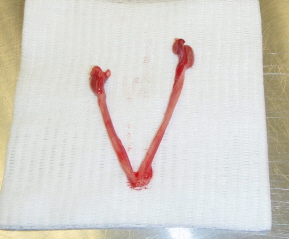
Why should I have my cat spayed?
Spaying your cat is essential, and there are several very good reasons for this:
- She will wander less - entire cats are inclined to wander more than neutered ones, this puts them at risk of accidents, particularly road traffic accidents, which are often fatal.
- Less risk of disease - Feline Aids (FIV) and Feline Leukaemia are both infectious and incurable diseases, and are more common in the feral cat population. An entire female will attract entire males, who are often feral or semi-feral and can carry these disease. To learn more about these diseases, click here
- Fewer health risks - entire female cats are at risk of developing pyometra, a very serious problem requiring emergency surgery where the uterus fills with pus, and are also more likely to suffer from mammary cancer.
- She will not call - an in season cat can be very tiresome, they will ‘call’ which is a yowling call that they can keep up for hours, roll on the floor and display themselves, vets often get phoned by panicking owners who think their young, female cat is in terrible pain, but who is really just in season! More of a problem is all the entire male cats she will attract.
- No kittens - having a litter of kittens can seem like a good idea, but they take a lot of looking after, can be expensive, and then you have to find homes for them, which can be difficult as there are a lot of unwanted kittens already.
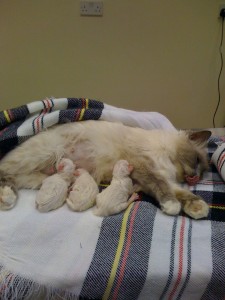
This cat is recovering from a caesarian section. It is a major procedure, the which is obviously avoided if they are spayed. It is also a costly operation, which can be several hundred pounds and often needs to be done as an emergency out-of-hours.
When should I have a cat be spayed?
- In general cats are spayed at about 6 months old, they do not have to have a season first, nor do you have to wait for a particular time in the cycle, like in dogs.
- It is best to spay them before the first season, which generally occurs around 8 months, but can be earlier, so there is no chance for them to become pregnant.
- Often charities or rescue centres will spay cats very young, from the ages of 3-4 months old, to ensure they are done before they are rehomed.
How is my cat spayed?
- Cats are spayed under a general anaesthetic, which is a safe and routine procedure in young cats, if you have any concerns, you should talk to your vet.
- Most vets in the UK will spay the cat through their flank, the incision is made though the cats left abdominal side. Cats are always spayed on the left, so if there is any confusion as to whether they have been done or not ( for example in a stray or rescue cat), vets know where to look for the scar.
- Sometimes cats will be spayed via the ‘midline’, which is in the middle of their tummy on the underneath, like dogs. This approach is often used if the cat is pregnant, and is more common in Europe and the USA.
- Spaying involves the removal of both the uterus and the ovaries.
- The wound is sutured in several layers, the muscle, subcutaneous fat and the skin. Some vets will place dissolvable sutures, others will place ones which have to be removed about 10 days post operatively.
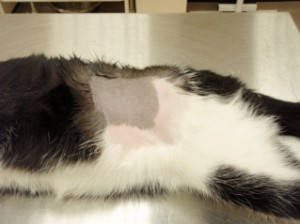
This cat is prepped for surgery, the hair is clipped from the flank region and the skin cleaned
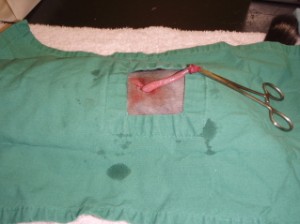
This picture shows a cat spay being carried out, one horn of the uterus as been removed
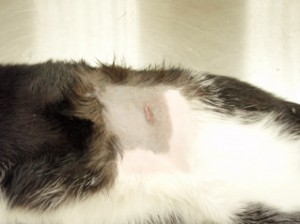
This is the same cat post surgery, the wound is small, and the sutures will dissolve.
Post operative care & complications
- Cats generally do very well after they have been spayed and are often back to normal within 24 hours
- The most important part of the aftercare of a cat spay is to as rested as possible for at least a few days, or until the sutures are removed, if they need to come out. This isn’t always easy with a young, lively cat but certainly they should be kept inside for about a week after the surgery.
- Your cat must not lick or chew at the wound, as they can introduce infection, cause the wound to swell or even remove the stitches. If you think this might happen, your vet should be able to provide you with a ‘buster collar’, a lampshade collar which will prevent them from reaching the wound.
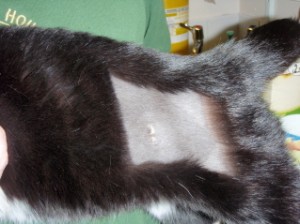
This picture shows a well healed spay site. The scar is not red or swollen. This cat has not bothered with her wound.
How much does it cost to spay a cat?
- The cost of a cat spay will vary between practices but it is always worth it for the health of your cat!
- Expect to pay between £40 and £60, which usually includes the price of the neutering, pain relief and sometimes anti-biotics and a buster collar.
- Some charities provide help to reduce the cost of neutering a cat, the main one is the Cats Protection League but there may be local a local organisation able to provide assistance, ask your vet.
- Occasionally it is possible to have a cat spay performed free of charge. Most often if you have rescued them from a charity. However, it is important to consider whether, if you can’t afford to have your cat neutered, if you can afford a cat at all, as there will be many other costs to cover in their lifetime.
Spaying Myths
- Having a litter is ‘good’ for my cat
- FALSE - there is no evidence that having a litter is beneficial in any way for your pet. Nor will having them spayed change their personality
- My cat is a house cat, she doesn’t need to be spayed -
- FALSE - it can be impossible to guarantee a cat is kept house bound all the time, especially if they are in season and trying to escape. Entire cats will still call, and they are also at risk from pyometra ( an infected uterus) and mammary cancer.
Please note, this is an advice only website, if you have any specific queries or concerns about your pet, you should contact your veterinary surgeon.